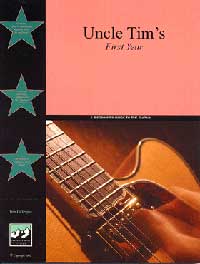

By Tim Gillespie
This month we will use chords to hear the differences within a key. The key of C major. What we are going to do is play combinations of chords and notice how they sound with chords within the key.







Get Your Musical Foundation In Place Now!
If you are struggling to know what chords are in what key or how the basic scale works within a key, you might be struggling when just a little information might make a HUGE difference.
You don't have to become a rules freak, but taking a little time to understand how a key works can take away ALL of that FRUSTRATION! And this is done visually so you do not need to read volumes to get it, just one thin book (88 pages).
Not knowing can stop your music right now and only understanding can make up for it. For $15, you can put this all to rest right now. Pick up a copy today.
eBooks are delivered instantly!
First we will play the major or primary chords in C major.



Notice These chords not only sound good together but they form a nice little progression all by themselves. This is the typical 1, 4, 5 progression. This progression more than any other, forms the backbone of rock and roll and the twelve bar blues. It is also often played as a one, five, four progression.
Next we will try it with the Minor chords.



Same result? It should sound similar. The relationships are the same as above. The only difference is these are minor chords relating to a minor key. They give you the minor chord sound because the third note is lower than a major chord.
Now lets play chords that share a common note and progress higher up the key.



Notice these chords contain one note from the previous chord, and one note from the next chord. Do you hear how sharing a common note gives the progression direction?
Lets try it with all the chords.







Notice what we are doing here. We are progressing through the key by playing every other chord. This way each new chord uses two notes from the chord before it and two notes from the chord after it. Also if we do this, we eventually play all seven chords.
We can get more complicated with this principle too! We can actually play seventh chords with basic chords inside the key and either duplicate notes throughout a progression or suggest movement by including a note or series of notes that moves either up or down the scale. It gets tricky to point out all the things gong on and keep it all straight but after a while it will all start to make sense.
In this example the first chord will contain all the notes of the second chord.














These are just a few of the ways you can think and organize the chords in a key. Not all of these combinations will sound good, but there are hundreds of ideas for songs and styles in this. You have the palette of chords in the key of C major and A minor, try a few progressions of your own and take a look inside the chords to see what is happening with the ones you like.
Also if you have the benefit of another guitarist. Select a progression and have the other guitarist play a scale (C major) over it. Have the motion of the scale travel up with the chords and contrary to it. In other words, play the scale downward while playing an upward progression of chords. Notice the contrary motion?
This is just the beginning. There is much more and we will come back to this in a few months. Think of this as an introduction.
I hope this helps you to become familiar with keys.
A chart of seventh chords in the key of C major.






